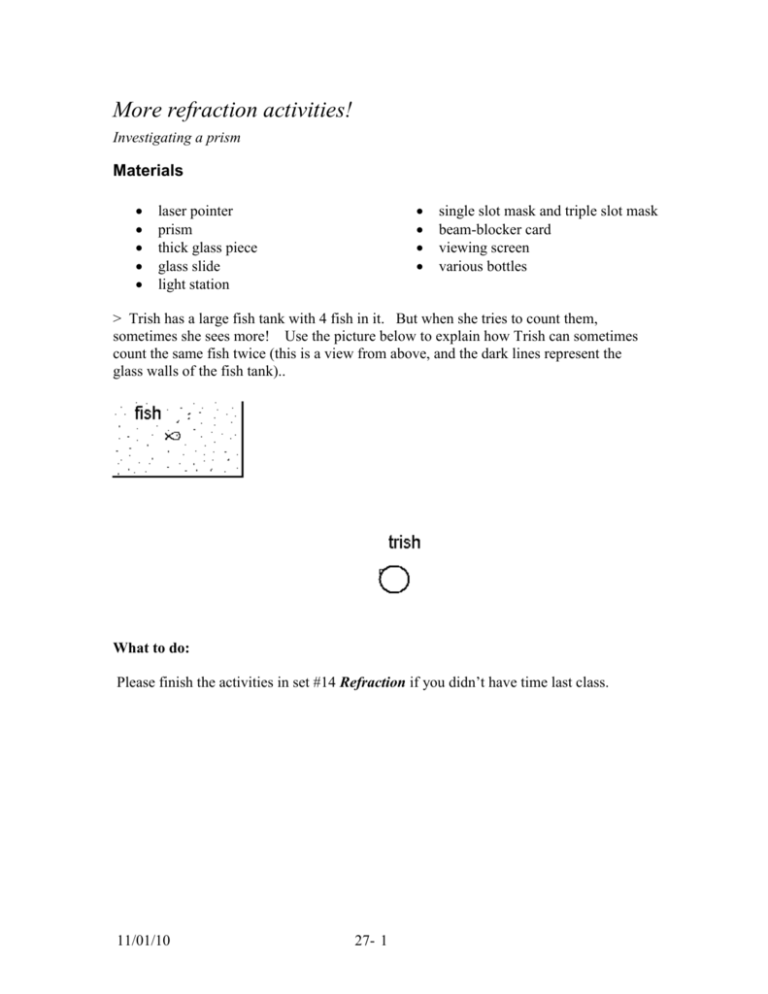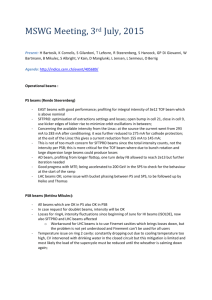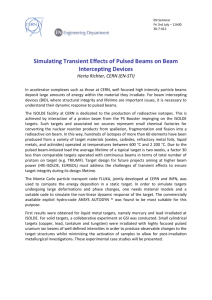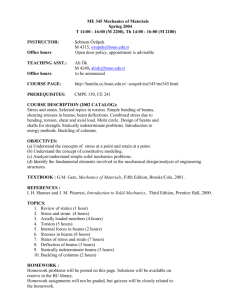What does refraction look like
advertisement

More refraction activities! Investigating a prism Materials laser pointer prism thick glass piece glass slide light station single slot mask and triple slot mask beam-blocker card viewing screen various bottles > Trish has a large fish tank with 4 fish in it. But when she tries to count them, sometimes she sees more! Use the picture below to explain how Trish can sometimes count the same fish twice (this is a view from above, and the dark lines represent the glass walls of the fish tank).. What to do: Please finish the activities in set #14 Refraction if you didn’t have time last class. 11/01/10 27- 1 1. Does a bottle of water make a shadow? Use what you have observed so far in this activity to predict whether or not water bottles make shadows. Write your prediction here: To investigate this: remove the mask from the light station and leave the front open. Stand the screen upright Put the bottles between light source and screen, and look for shadows on the screen. Describe two things that you learned. 2. Using the three-slot mask on the light station, explore how ovalshaped bottle filled with water affects the light beams. Put the bottle in its place on Beam Observation Page 2. Record what happens to the beam by drawing on the paper. Summarize what you observe. 11/01/10 27- 2 Set up the light station with the single slot mask, and adjust the white card to make a very narrow beam. Place the viewing screen on the table top, to reveal where the light beam goes. 3. Place the thick glass piece in the beam (standing up). Observe what happens when you turn the piece so that light encounters it at an angle. There are both reflected beams and refracted beams. Which are the reflected beams, and which are the refracted beams? 4. Compare this to what happens with the glass slide. Explain any differences you observe. 5. Place the prism in the light beam so that the beam hits one face (not a corner). There are both reflected beams and refracted beams, and even beams that are both reflected and refracted. On the diagram below, record what you see for some case. Draw lines inside the triangle showing how the light gets from where it enters to where it leaves. 6. Observe what happens to the various beams as you turn the prism. Record two observations. 11/01/10 27- 3 7. Aim the laser pointer back along one of the beams. Does the light go back to the light station along the same path, or does it do something else? 8. As you turn the prism, one of the beams becomes colored and then abruptly disappears, while another becomes brighter. What paths are these beams taking as they go through the prism? Check: Discuss your findings with an instructor. 9. In diagram A, below, show what will happen to a laser beam directed towards a wedge made of some material. In diagram B, show what happens to three parallel laser beams. 10. In diagram B, the light beams cross somewhere (“the focal point”) after going through the six-sided object. Suppose instead there were a light source at the focal point, emitting light towards the six-sided object. What would happen to these light beams? 11/01/10 27- 4 11. If we want every parallel beam to go to the same focal point, we need an object with a curved surface (a lens). On this diagram, continue the lines to show how the light beams come together at the focal point. 12. Another way to accomplish this is to use many wedge-shaped pieces (this is called a Fresnel lens (the word is pronounced “fre-NELL”). Draw lines showing how all the light beams come together at the focal point. 11/01/10 27- 5 13. Lighthouses are put on reefs and islands to warn ships. If an ordinary light source (that sends light in all directions) is used, most of the light is wasted. Draw lines showing the useful light beams. 14. The solution to the light house problem is to use a Fresnel lens to direct most of the light towards the ships. Draw some lines showing how the light is redirected 11/01/10 27- 6 Each group should hand in one copy of this page Group: Names of group members present: 15. Explain, what does refraction have to do with clear objects making shadows? 16. A laser beam is directed towards a prism, as shown. Three visible light beams result: A) light that is reflected from the front surface, B) light that enters the prism, travels to a different surface of the prism, and leaves it; C) light that enters the prism, travels to a different surface of the prism where it is reflected, travels to yet another surface (perhaps the first one, again), and leaves there. Please draw in the path taken by these three beams (labeling them A, B, C).. 11/01/10 27- 7






